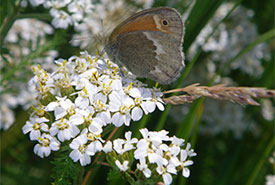
Maritime ringlet (Photo by NCC)
Maritime ringlet
The maritime ringlet is one of the most endangered butterflies in Canada. The entire global population is confined to a small area in Quebec and New Brunswick.
What does it look like?
Maritime ringlets are dark to ochre-brown on the upper side of their body with a greyish border on their wings. There is, occasionally, a dark eyespot with a white halo on the upper side of their front wing. The underside of their front wings is dark ochre and grey, with a prominent, irregularly shaped cream-coloured band in the centre. Female ringlets are more ochre-coloured and usually have a more defined eyespot. The wingspan of this small butterfly ranges from 3.2 to 3.6 centimetres.
Where does it live?
The global range of this small butterfly is restricted to 10 scattered locations along coastal salt marshes in northern New Brunswick and the southern coast of the Gaspé Peninsula in Quebec, around the Baie des Chaleurs.
What is this species’ conservation status?
The Committee on the Status of Endangered Wildlife in Canada assessed the maritime ringlet as endangered. This species’ survival relies on salt marsh habitat with suitable plants throughout its lifecycle. Saltmeadow cordgrass hosts the larvae and sea lavender provides nectar for the adults.
Threats include rising sea levels and increasing frequency of storm surges as a result of climate change, as the seaward edge of current salt marshes get submerged. Marsh habitat may expand as coastal plants slowly migrate inland following the tides as sea level rises, if unimpeded by natural or human created barriers. Other threats include habitat fragmentation, coastal development, marsh infilling and pollution from industrial effluent. Many of the populations are small and isolated making them very vulnerable to extinction.
What is NCC doing to protect habitat for this species?
NCC protects habitats that could support maritime ringlets, including a three-hectare (seven-acre) property on the Baie des Chaleurs in the Gaspé Peninsula. There is a relatively large area of potential habitat in the Bay of Chaleur region, although most of it is concentrated northeast in the Shippegan, Lameque Island, and Miscou Island area, which is widely separated from the known Maritime ringlet populations in Nepisiguit Bay. We are continuing to seek opportunities to secure more of the habitat this endangered species needs.




